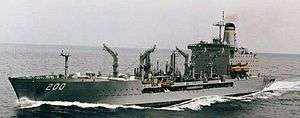USNS Guadalupe (T-AO-200)
USNS Guadalupe (T-AO-200) is a Henry J. Kaiser-class underway replenishment oiler operated by the Military Sealift Command to support ships of the United States Navy.
 USNS Guadalupe (T-AO-200) | |
| History | |
|---|---|
| Name: | USNS Guadalupe |
| Namesake: | The Guadalupe River in Texas |
| Ordered: | 6 October 1988 |
| Builder: | Avondale Shipyard, Inc., New Orleans, Louisiana |
| Laid down: | 9 July 1990 |
| Launched: | 5 October 1991 |
| In service: | 25 September 1992-present |
| Identification: |
|
| Status: | In active Military Sealift Command service |
| Badge: |
 |
| General characteristics | |
| Class and type: | Henry J. Kaiser-class fleet replenishment oiler |
| Type: | Fleet replenishment oiler |
| Tonnage: | 31,200 deadweight tons |
| Displacement: |
|
| Length: | 677 ft (206 m) |
| Beam: | 97 ft 5 in (29.69 m) |
| Draft: | 35 ft (11 m) maximum |
| Installed power: |
|
| Propulsion: | Two medium-speed Colt-Pielstick PC4-2/2 10V-570 diesel engines, two shafts, controllable-pitch propellers |
| Speed: | 20 knots (37 km/h; 23 mph) |
| Capacity: |
|
| Complement: | 103 (18 civilian officers, 1 U.S. Navy officer, 64 merchant seamen, 20 U.S. Navy enlisted personnel) |
| Armament: |
|
| Aircraft carried: | None |
| Aviation facilities: | Helicopter landing platform |
| Notes: |
|
Guadalupe, the fourteenth ship of the Henry J. Kaiser class, was laid down at Avondale Shipyard, Inc., at New Orleans, Louisiana, on 9 July 1990 and launched on 5 October 1991. She entered non-commissioned U.S. Navy service under the control of the Military Sealift Command with a primarily civilian crew on 25 September 1992. She serves in the United States Pacific Fleet. In June 2004, USNS Guadalupe rescued 13 crew and a dog from the burning Taiwanese fishing vessel Hsin Chin Chanz, around 900 miles north east of Guam in the Pacific.[1]
Design
The Henry J. Kaiser-class oilers were preceded by the shorter Cimarron-class fleet replenishment oilers. Guadalupe has an overall length of 206.5 metres (677 ft 6 in). It has a beam of 29.7 metres (97 ft) and a draft of 11 metres (36 ft). The oiler has a displacement of 41,353 tonnes (40,700 long tons; 45,584 short tons) at full load. It has a capacity of 180,000 imperial barrels (29,000,000 l; 6,500,000 imp gal; 7,800,000 US gal) of aviation fuel or fuel oil. It can carry a dry load of 690 square metres (7,400 sq ft) and can refrigerate 128 pallets of food. The ship is powered by two 10 PC4.2 V 570 Colt-Pielstick diesel engines that drive two shafts; this gives a power of 25.6 megawatts (34,800 PS; 34,300 shp).
The Henry J. Kaiser-class oilers have maximum speeds of 20 knots (37 km/h; 23 mph). They were built without armaments but can be fitted with close-in weapon systems. The ship has a helicopter platform but not any maintenance facilities. It is fitted with five fuelling stations; these can fill two ships at the same time and the ship is capable of pumping 900,000 US gallons (3,400,000 l; 750,000 imp gal) of diesel or 540,000 US gallons (2,000,000 l; 450,000 imp gal) of jet fuel per hour. It has a complement of eighty-nine civilians (nineteen officers), twenty-nine spare crew, and six United States Navy crew.
References
- This article includes information collected from the Naval Vessel Register, which, as a U.S. government publication, is in the public domain. The entry can be found here.
- Shipping magazine No.174 August 2004 p.10 with picture
External links
| Wikimedia Commons has media related to IMO 8822442. |
- NavSource Online: Service Ship Photo Archive: USNS Guadalupe (T-AO-200)
- USNS Guadalupe (T-AO-200)
- Wildenberg, Thomas (1996). Gray Steel and Black Oil: Fast Tankers and Replenishment at Sea in the U.S. Navy, 1912-1995. Annapolis, Maryland: Naval Institute Press. Retrieved 2009-04-28.